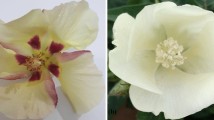Summary
1. Further experiments are described on the mode of inheritance and distribution in six species of New World cottons of a pair of duplicate factors for chlorophyll deficiency.
2. Duplication of factors is considered to have taken place through polyploidy with subsequent mutation of one or other of the members constituting the pair in some of the species.Barbadense andDarwinii have become monomeric through the loss of factorC hb whilepurpurascens, hirsutum, andtaitense, when monomeric, are shown to have lostC ha .
3. The experimental data support Haldane’s view that in polyploid species one member of a pair of duplicate genes may mutate without disadvantage, provided its functions can be performed by a gene in one of the other sets of chromosomes.
4. The taxonomic and evolutionary significance of the results is discussed and it is suggested that the extent to which the dimeric condition is converted to the monomeric in polyploid species may provide some indication of the age of the species. In an old series of allopolyploids such as the New World species ofGossypium are considered to be, cases of dimery might be expected only infrequently, and usually only in interspecific crosses.
Similar content being viewed by others
References
Dahlgren, K. V. O. (1915). “Ein Kreuzungsversuch mitCapsella Heegeri Solms.”Svensk Bot. Tidsk. 9, 397.
Fisher, R. A. (1930).The genetical theory of Natural Selection. Oxford: Clarendon Press.
Gaiser, L. O. (1930). “Chromosome numbers in Angiosperms. II.”Bibliogr. Genet. 6, 171.
Haldane, J. B. S. (1932).The causes of Evolution. London: Longmans, Green and Co.
—— (1933). “The part played by recurrent mutation in evolution.”Amer. Nat. 67, 5.
Harland, S. C. (1919). “Inheritance of certain characters in the cowpea (Vigna sinensis).”Journ. Gen. 8, 101.
—— (1932a). “The genetics of cotton. Part VI. The inheritance of chlorophyll deficiency in New World cottons.”Journ. Gen. 25, 271.
—— (1932b). “The genetics ofGossypium.”Bibliogr. Gen. 9, 107.
Shull, G. H. (1914). “Duplicate genes for capsule form inBursa bursa-pastoris.”Zts. ind. Abst. u. Verer. 12, 97.
—— (1918). “The duplication of a leaf-lobe factor in the shepherd’s purse.”Brooklyn Bot. Gard. Mem. 1, 427.
Skovsted, A. (unpublished). “Cytological studies in cotton. Part 2. Two interspecific hybrids between Asiatic and New World cottons.”
Trow, A. H. (1916). “On ‘Albinism’ inSenecio vulgaris L.”Journ. Gen. 6, 65.
Author information
Authors and Affiliations
Rights and permissions
About this article
Cite this article
Harland, S.C. The genetics of cotton. Journ. of Genetics 29, 181–195 (1934). https://doi.org/10.1007/BF02982195
Issue Date:
DOI: https://doi.org/10.1007/BF02982195




